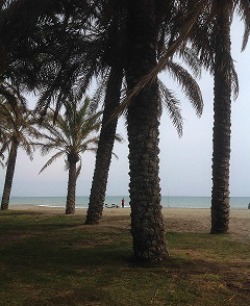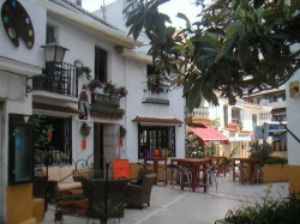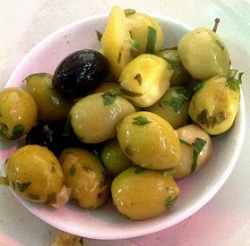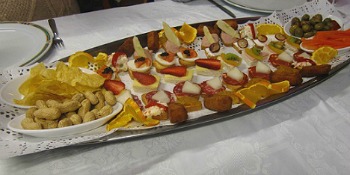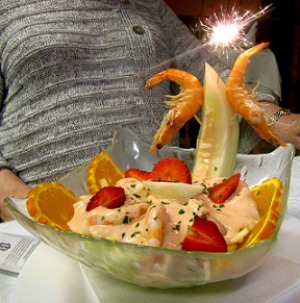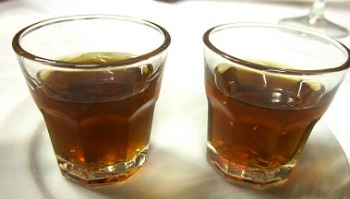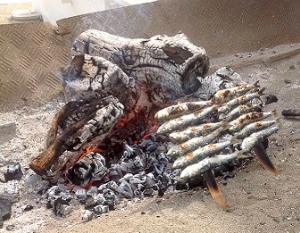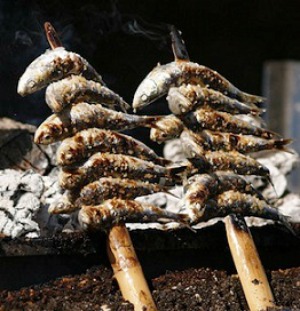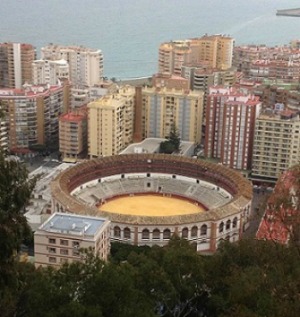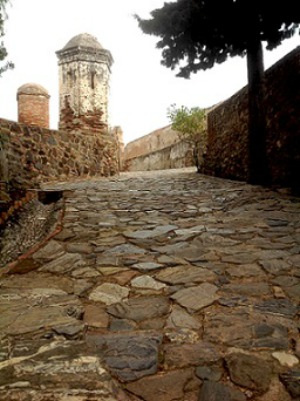Torremolinos and Malaga, Spain
By Nancy Hartman of What’s Cooking America
Welcome to What’s Cooking America’s Spanish travel log, Food Travels Spain- Andalusia (Spanish: Andalucía, España). Over the last two weeks of March 2014, we traveled southwest Spain visiting a variety of cities and enjoying wonderful hospitality, cuisine, and weather.
Please join for the next few weeks as we share our adventures, recipes, and insights of our exploration of Andalusia Spain. I have taken liberties with the language to season the story. I have attempted to sprinkle a few Spanish words and phrases in the log in hopes of giving you taste of Spain as you meander through our journey.
¿Dónde está Andalucía, España?
Andalusia is in the south of the Iberian Peninsula. It is a region of ancient cities, deserts, and amazing beaches along the Costa del Sol and Costa de la Luz. It is home to the Sierra Nevada mountain range where the highest mountain in Spain is found and the most southerly ski resort in Europe. On a map you will find Andalusia:
South of Extremadura and Castile-La Mancha;
West of Murcia and the Mediterranean Sea;
East of Portugal and the Atlantic Ocean;
North of the Mediterranean Sea and the Strait of Gibraltar in the Province of Cadiz, by the British overseas territory of Gibraltar. Here the Alboran Sea separates Spain from North Africa by just a few miles.
Our Camino: We started our Journey in Málaga. From there we travelled to Torremolinos, Ronda, Tarifia, Morocco, Gibraltar, Jerez de la Frontera, El Pureto de Santa Maria, Olvera, Antequera, Granada, Almería, Motril, back to Málaga, and finally Madrid Barajas.
Driving in Spain: At first we were concerned about driving in a foreign county, but having our GPS, nick-named the “Queen” aboard was comforting as she guided us calmly to and from every Spanish city we visited. The many roundabouts, at first were intimidating, but we soon learned if you miss your exit, no worries, just go around again. On our flight home we found out that the reason we did not see any police patrolling the Autovista and the abundance of amazingly courteous drivers is because they have traffic cameras everywhere! We have been thinking back to those surprisingly quick drives and hope that the country of Spain doesn’t come calling too soon.
Pessimistic Youth Are Universal: If you talk to the youth of Spain, they will tell you that the food of Spain has been saturated with western influence and has vastly changed over the last 20 years with the encroachment of establishments such as McDonalds and Burger King. What the youth have yet to discover is that the Spanish tradition, culture, and food is alive and well in the older generations, family restaurants, and small cities throughout the region. They just need to get out and look.
Our Journey Theme: Barriga llena corazon contento (full stomach, happy heart).
Portland, Oregon to Madrid, Spain:
We flew Delta Airlines from Portland, Oregon, connected in Atlanta, then off to Madrid for another 8 hours in the air. A 5-hour layover and then a short hop to Malaga and Torremolinos for our first destination in Spain.
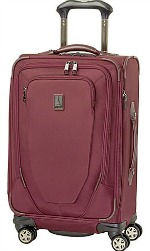 Travel Gear – Haversacks to Steamer Trunks: On this trip our group opted to travel our 14-day tour of Andalusia with only carry-on suitcases. A new revelation for my Mother who “Could Not” possibly pack all the needed items in a carry on; or so she thought! I was liberated two-years before when traveling standby with a friend on a Delta flight to Amsterdam. We traveled to Europe for 18 days with our carry-on luggage.
Travel Gear – Haversacks to Steamer Trunks: On this trip our group opted to travel our 14-day tour of Andalusia with only carry-on suitcases. A new revelation for my Mother who “Could Not” possibly pack all the needed items in a carry on; or so she thought! I was liberated two-years before when traveling standby with a friend on a Delta flight to Amsterdam. We traveled to Europe for 18 days with our carry-on luggage.
For our trip the carry-on luggage won the vote, three-to-one. Mom decided that she would not be the only one hauling a 3-piece luggage set all through Spain so she started to watch YouTube videos on, “Packing it all in your carry on.” It also helped that we booked an apartment during the halfway point of our trip, so that we would have access to a washing machine to wash our clothes. My previous trip we did a sink washing on the cruise ship. My Mom is happy to report that at the end of our trip, she still had two unused clothing items and yes, you can just take a carry on suitcase and survive!
Mile-high Seating: Our Delta flight was great. We spent considerable time booking, picking seats, and upgrading to economy comfort on our overseas leg of the trip. I find that if you book far enough in advance you have time to view the plane seating and pick the most comfortable arrangement for your group. The four extra inches from the Economy Comfort upgrade really made a difference on the longer leg of the flight, plus we received free cocktails! We had a 5-hour layover and then a short hop on Iberian Airlines to Málaga where we picked up our rental car and drove the short distance to Torremolinos for our first destination in Spain.
Destino – Torremolinos, Spain:
We arrived in Málaga and drove to Torremolinos to check in at our hotel. The only thing we still needed after our long flight – good food!
Torremolinos is a municipality on the Costa del Sol of the Spanish Mediterranean; a quaint beach town about a 10 minute drive from the Málaga airpuerto. It has an ever waiting coast line, stacked with lounge chairs, umbrellas, and water toys waiting for the upcoming tourist season that would bloom after the Easter holiday. Playa de la Playamar is a lovely beach with golden sands, a palm grove, restaurants, and cafes. Our hotel was located across from the boardwalk and beach. Our trip was perfect timing just before the season starts. The weather was warm enough, with plenty of parking and no lines in the local restaurants.
Comida – Our First Supper: Our first night, we were referred by our hotel for dinner to Restaurante Don Canapé, a family owned business that pays great attention to details. With no lines in the early season and our appetites still on a U.S. schedule, we arrived just before 7:00 p.m. – a little early for the Spanish dinner hour. Most Spanish dinners are not until after 9:00 p.m.
The owner, Juan Antonio, opened the doors for us early, and we sat down to experience some wonderful Spanish hospitality and our first challenge of ordering in Spain. Fortunately for us, the menu was offered in five different languages which helped to ease us into the many new food experiences to follow in the next two weeks.
After ordering, Juan Antonio brought us a large tray (not a plate) of colorful canapes to sample (which was included with our meal and a sweet treat Berenjena Frita con Miel de Cana). This is a typical dish from the Granada and Malaga areas of Andalusia. It is quick, easy, and inexpensive to prepare. The main ingredients are eggplant and miel de cana (dark sugar cane syrup).
Andalusian Marinated Green Olives
Fragrant with herbs and spices, these olives are fantastic! Olives are a typical appetizer and partner particularly well with a glass of chilled dry sherry, which also comes from Andalusia. Every lunch and dinner in Spain started with a bowl of delicious olives!
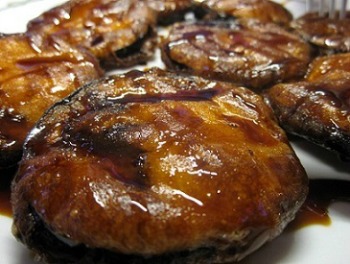
Berenjena Frita con Miel de Cana
Fried Eggplant with Molasses Recipe
Our dinner was simple, yet perfectly prepared, with little touches of fun made it a delight! My Mom ordered the menu del dia (the menu of the day) and was delighted with the value and creativity that they added to the meal. Her shrimp cocktail came complete with a burning sparkler! After dinner, Juan Antonio shared with us how to make the Berenjena Frita con Miel de Cana bringing out the ingredients so we could write them down. We finished the meal off with a complimentary after-dinner digestive of small cups of Malaga Virgin Sherry.
Sardines Don’t Really Live in a Can: As is a Spanish custom, we took an evening walk along the Paseo Marítimo where you will find Pescaito frito (spit-roasted sardines) roasting outdoors on small boats at almost every chiringuito (beach restaurant) on the Paseo Marítimo. They looked delicious and the smell was heavenly!
Torremolinos has the honor of being the origin of the term pescaíto castizo (the fried or roasted fish) widely consumed in Andalusia. The origin of the Pescaito castizo or Pescaito frito is from the fishing village of La Carihuela, in the early 1960s. To find the most authentic pescaíto in the Costa del Sol, visit the La Carihuela neighborhood. You will also find them in many of the bars and restaurants along the beach and streets all through Torremolinos.
Although you can enjoy the Pescaito frito anytime, for a real treat plan your visit on The Day Pescaíto (Day of the sardine or small fish) on the first Thursday of June each year; it is hailed as a gastronomic journey! The Day Pescaito has been held since the late 1980s and is organized by the city of Torremolinos and tourism businesses in the municipality. The festival takes place in the district of La Carihuela and along the boardwalk almost to the Benalmadena Marina. During the festival, the bars and restaurants provide free portions of fish and drinks to tourists and locals.
Pescaito frito – Spit-Roasted Sardines
Destino – Malaga, Spain:
Picasso – we call him Pa-ci-ci-o: We had time to visit the Museo Picasso in the town of Malaga where Picasso was born, and ponder many of Picasso’s interesting works. The Museum opened in 2003 in the Buenavista Palace, and has 285 works donated by members of Picasso’s family. More than 200 works cover the different styles, materials, and techniques used by Picasso. All the paintings were protected by glass covers, and a guard stood by and watched you in every room of the museum. Most of the paintings made you really wonder about Picasso’s mental health!
A View From The Top: We also took a trip up to the Castillo de Gibralfaro. The site of the ancient gunpowder arsenal houses offering a vision of the use of the Castillo as a military garrison and coastal lookout post from 1487 (a year of Malaga’s incorporation in the Crown of Castile) until 1925. It was a beautiful walk along the rampart that overlooked Malaga, the port, and of course the Plaza La Malagueta where corrida de toros (bull fights) are held during the season, between April and September.
Travels in Andalusia, Spain – Indexed by Cities Visited:
Torremolinos and Malaga, Spain – Part 1
Tangier, Morocco (Africa) – Part 4
Gibraltar, United Kingdom – Part 5
Jerez de la Frontera, Spain – Part 6
Olvera and Antequera, Spain – Part 7
Granada and Almeria, Spain – Part 8
Madrid Barajas, Spain – Part 10
Categories:
Food Travels in Spain
